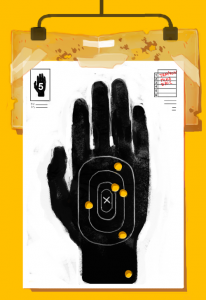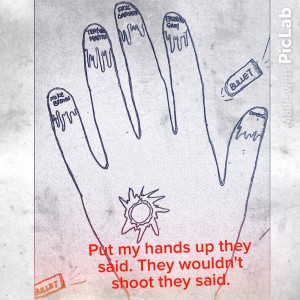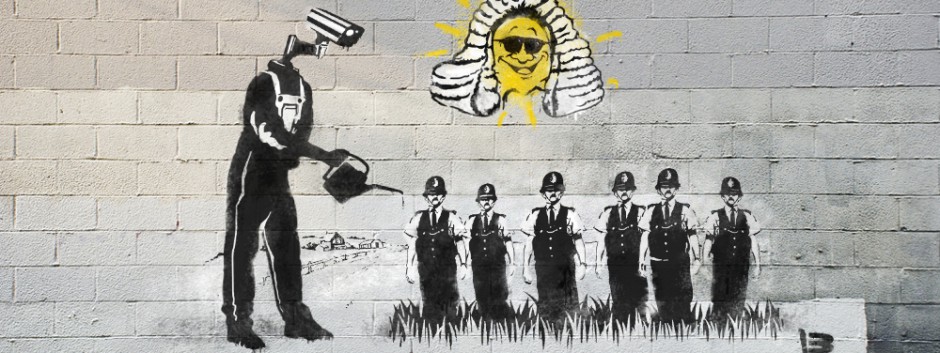Reflection of Project
This project was a brain blast for me. I found myself stuck and re-envisioning my idea quite a few times. I knew that I wanted to focus on the images and videos generated by social injustices however I was not sure as how electracy has helped or tarnished the fight for justice. My thinking process was a confusion of thought. I had so many ideas but having it be to perform a new type of electrate writing; a type of writing I did not know how to develop. I began with an idea of creating a video that showcased how social injustice has become the butt of jokes but however these jokes have been able to raise both good and a bad influence. In the process of doing this I came upon my final idea of how much influence electracy places on social injustices and the spotlight it where by shines of on the subject.
I think that my peers have created some very strong project and have highlight how electracy is having both a positive and negative influence on the content of the internet. I think Pamela produced the strongest project in her showcase of the Victoria Secret Ad Campaign. The content she generated proved to how productive this apparatus is but however showed that there is still a lot of work for it to move ethically forward. Overall, I do believe everyone did well in performing the task. I do believe that we struggled in conceptualizing the idea. In that sense I think my peers pulled off a very representation of the project. With that said I gave very advice that I believe would help move the project forward as I do believe they did the same for me. We all handled all the criticism well in order to create a productive and well informed project.
I think this project is more so suitable for a final project. There is a lot of work that can be generated and can create a very strong project in the end. This project has a lot of details that entail more than a weeks worth of research and play. I do believe that with the challenge all of us performed greatly and produced a range of ideas that showcase how we can move eletracy ethically and productively into the future. In order to move forward I think it is imperative that you understand this is still a work in progress. A creation that I hope will spread and generate conversation and opinions both negative and positive.
Electracy has shaped many aspects of our lives as we know it thus far, from the way we write to the way we learn. Electracy a coined theory set forth by Gregory Ulmer that sets the stage for how communication is to be exploited in this new age of technology. Electracy is an apparatus that allows us to constantly engage in virtual worlds where we can readily take part in conversations that allows us to create traces for people, politics, and places. This apparatus has been a streaming channel that aids social injustices and even though electracy has moved us past literacy it still helps us to bridge the two concepts together. With that let’s address the aspect of how electracy has placed a great impact on social injustice in the way by which it generates awareness in social media.
Many activist take to YouTube, Tumblr, Facebook, Twitter, Instagram and other social media sites to post opinions. They repost art that is affiliated with causes such as the recent injustices of young African American men being targets of police brutality. These people also create hashtags, submit comments, actively retweet, and share links. Of all of this, the biggest impact electracy has, is on those who exert the power to share their opinions by publicly displaying their choice of either going against the fight by proclaiming their “idiocy in their videocy” (Robert Leston, et. al.) or by proclaiming a strong want for change in the situation. Either way these new methods of social protesting for social injustices get the word out FAST and it spreads like a forest fire on the internet. Even if these active social site users have a hard time generating attention on their creative videos, vines, or memes the slogans they create leave traces for anyone who is left out of the loop to jump on a bandwagon as quick as possible. These slogans are shared and hashtagged not due to quality or concern for ethical standards but due to the fact that the opinions whether good or bad must be shared, seen, and must above all in turn create a response.
Recently, there has been a lot of social injustices as it would seem in the African American Community which has caused a lot of turmoil not only in the real world but in the virtual world as well. Young African American men are being targets of police brutality and this occurrence has stirred a lot of controversy. Many of those who are outraged by this situation have taken to the social media highway to make their opinions known. This new medium has been the platform for activists or those who believe the problem is no problem at all to have their events and opinions not only heard but given the possibility to become viral.
Slogans such as the, “Hands up don’t shoot” was created due to the shooting of Mike Brown in Ferguson, Missouri. This slogan has been made into clothing, created, shared, hashtagged and retweeted to get the word out about this injustice. Even though this is clearly not the first social injustice to occur it is one of the fastest spreading and attention generation movements in the country today. Due to the option of uploading a video, picture, or comment that engages this slogan it allows social injustices such as the Mike Brown’s death to heard and publicized. Anyone with a technological device that connects to the internet can readily engage in a topic such as the hands up don’t shoot slogan that can raise attention and help generate more and more interest by leaving a trace.

http://sachinteng.tumblr.com/ – has art created for Eric Garner, Trayvon Martin, Mike Brown
Take for example this art depicting the hands up don’t shoot slogan. I came across it just as anyone else would who has searched on Tumblr for such depiction of the slogan. Although, the slogan or art may not always engage viewers in a positive way even the negativity displays the participation in the fight for Mike Brown, Trayvon Martin, and Eric Garner. I guess what they say is true, any publicity is good publicity. After the point of engaging participants there is no turning back. There is no cap on how far an image such as this will spread. Before you know it a friend is asking you, “have you seen that picture…” this is the point of where one knows that the image is generating attention and has something that draws in an audience. By this point there have been memes generated, so many retweets, and the hashtags have been used so many times that we can no longer remember how we saw these injustices before it. This phenomenon occurs due to tubing. The linking of one apparatus of electrate reasoning to another that simulates the viral aspect of the internet.
In all of this I came to remember Lewis Mumford, the author of, “The Automation of Knowledge”. In this Mumford went onto explain the automation of certain techniques such as the scientific method and how by doing this in turn create apparatuses that operates without direct control. This made me think of how these images spread after being published on the web without the control of the artist or creator. These propagandist images that are created in memory and protest for victims such as Brown float on the internet without direction. People bounce these images all over the internet and even like me go onto create imitations of them. It is without say that there is no control, we add content, opinions, and new iterations of the image. There is no control on what is said or how the image is interpreted.
 In this same aspect of the previous image, I tried generating an image that collaborates with a slogan for the fight of social injustices mentioned before. I tried to create an art work that would possibly stimulate the same effects. I created the image to the right and posted it on my Tumblr blog. However, I found the task not to be what I expected. Although, the thought behind the creation was solely for this project I did have feelings of the injustices faced by victims such as Mike Brown. I was faced with the daunting task of depicting the creativeness of the situation but also portraying the pain and relevance of it. I had to create an image that would portray such pain but had my own alternative motive of becoming viral. I found this to be the first unethical point. I was creating this picture for some sort of recognition. I was creating this picture with the intention that it would spread and more so not because of the problem it was addressing but due to my creativity. However, my project did not spread across the internet as others have for few reasons I believe. First, the timing in which I created this art piece was not a time where I believe the fight for these mentioned injustices were at a high. Another reason I believe is because I only posted it on social media site where I have few followers who may have not found the image interesting or important. I did not catch their or influence them enough to generate conversation. Lastly, I believe my project failed to become viral due to that maybe there is misconception or misunderstanding of my image even though the caption pertains to the topic the actual drawing could be seen as chocolate covered finger tips instead of bleeding ones.
In this same aspect of the previous image, I tried generating an image that collaborates with a slogan for the fight of social injustices mentioned before. I tried to create an art work that would possibly stimulate the same effects. I created the image to the right and posted it on my Tumblr blog. However, I found the task not to be what I expected. Although, the thought behind the creation was solely for this project I did have feelings of the injustices faced by victims such as Mike Brown. I was faced with the daunting task of depicting the creativeness of the situation but also portraying the pain and relevance of it. I had to create an image that would portray such pain but had my own alternative motive of becoming viral. I found this to be the first unethical point. I was creating this picture for some sort of recognition. I was creating this picture with the intention that it would spread and more so not because of the problem it was addressing but due to my creativity. However, my project did not spread across the internet as others have for few reasons I believe. First, the timing in which I created this art piece was not a time where I believe the fight for these mentioned injustices were at a high. Another reason I believe is because I only posted it on social media site where I have few followers who may have not found the image interesting or important. I did not catch their or influence them enough to generate conversation. Lastly, I believe my project failed to become viral due to that maybe there is misconception or misunderstanding of my image even though the caption pertains to the topic the actual drawing could be seen as chocolate covered finger tips instead of bleeding ones.
With that said, I must say that in this age of electracy feelings are more so accepted and in a way that impeaches the ethics of the internet due to the fact that everyone believes their voices should be heard and broadcasted no matter the content. However, this might contradict my previous statement but the ethics of the internet are evolving. What we say and what we do on the internet creates a trace and this trace in a way helps social injustices such as Brown’s death to be known and seen for the pain that it really is. Nevertheless, I did experience something new when creating this project. I was able to play. I was able to create something that produced a productive influence in a situation that had so much negativity and sadness. I was able to contribute something, leave a trace that would help those who fight for the death of Mike Brown and others.
Lastly I noticed that I was participating in some form of entertainment. In social injustices there is very little room for laughter or drama, yet in much of the content produced by muse of social injustices are somehow made into comical satires, talk show punch lines, or parody songs. Sadly, however troubling or ethically incorrect this may all seem this entertainment aspect adds to the cause, they add fuel the fire that generates protest for both sides, generates talks both political or social, and creates platforms that tube more content in media that are both creative and productive. Electracy just like the social injustices of Mike Brown and others are now becoming more apparent. The ethical responsibility of electracy is to help push topics such as the social injustices of Mike Brown and others to the forefront. Although, electracy might not always help present these issues in ways that might stipulate right and wrong behaviors it does allow a certain amount of productivity that allows everyone no matter which side of protest they stand to become involved. This involvement links one idea to another, generates conversation, and even shake some controversy. All of these are needed in order to successfully continue the evolution of electracy and also to help the fight social injustices of young African American men such as Mike Brown and others.




Hi Mariah,
A very deep project.
In your introduction, it would be good to explain what electracy is.
When you say “This apparatus has been a streaming channel that aids social injustices.”, I think you could explain if further. Even though you do further down, in the begining it gives an unclear impression. Also I am not sure if you are saying that there is something unethical about either of the images in your project?
Hey Mariah,
I love this project. I specifically enjoy the picture that you drew and posted on your tumblr. I think it would be interesting to hear your thoughts on why your picture didn’t take in a viral direction. This is topic that is being constantly discussed and analyzed, you’d think that this would generate some, even the slightest, attention. And I’d be curious to hear your ideas about your picture in that larger scheme.
Hi Mariah, truly you knocked it out the ball park, excellent project! I’d suggest that you name the book where you got the quote from ““idiocy in their videocy”. Do you think that this oversharing of information is diminishing our ethical views on certain things? Why do you think that the first image you took did not get spread easily on Tumblr? Do you think you the joy/sadness relates to this?
Hey Mariah,
Glad to see the direction this is taking.
I’ve got a lot of notes on this.It’s got great potential, and I think would benefit from some discussion. Let’s talk about it this week.
Hey Hey Mariah,
First of all, you are a great writer. I think you did a good job in explaining and getting your point across to the readers. I love your drawing and i think its amazing, maybe if you had put color, we wouldn’t think its chocolate covered fingers. lol. You should include why you think your image didn’t spread. Overall, good job.